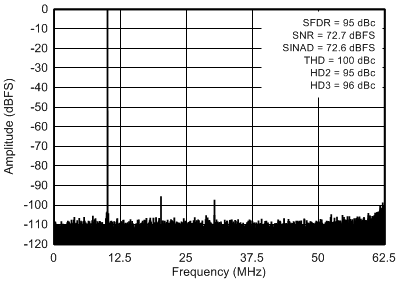SBAS670B July 2014 – April 2017 ADC3441 , ADC3442 , ADC3443 , ADC3444
PRODUCTION DATA.
- 1 Features
- 2 Applications
- 3 Description
- 4 Revision History
- 5 Device Comparison Table
- 6 Pin Configuration and Functions
-
7 Specifications
- 7.1 Absolute Maximum Ratings
- 7.2 ESD Ratings
- 7.3 Recommended Operating Conditions
- 7.4 Thermal Information
- 7.5 Electrical Characteristics: General
- 7.6 Electrical Characteristics: ADC3441, ADC3442
- 7.7 Electrical Characteristics: ADC3443, ADC3444
- 7.8 AC Performance: ADC3441
- 7.9 AC Performance: ADC3442
- 7.10 AC Performance: ADC3443
- 7.11 AC Performance: ADC3444
- 7.12 Digital Characteristics
- 7.13 Timing Requirements: General
- 7.14 Timing Requirements: LVDS Output
- 7.15 Typical Characteristics: ADC3441
- 7.16 Typical Characteristics: ADC3442
- 7.17 Typical Characteristics: ADC3443
- 7.18 Typical Characteristics: ADC3444
- 7.19 Typical Characteristics: Common
- 7.20 Typical Characteristics: Contour
- 8 Parameter Measurement Information
-
9 Detailed Description
- 9.1 Overview
- 9.2 Functional Block Diagram
- 9.3 Feature Description
- 9.4 Device Functional Modes
- 9.5 Programming
- 9.6
Register Maps
- 9.6.1
Serial Register Description
- 9.6.1.1 Register 01h (address = 01h)
- 9.6.1.2 Register 03h (address = 03h)
- 9.6.1.3 Register 04h (address = 04h)
- 9.6.1.4 Register 05h (address = 05h)
- 9.6.1.5 Register 06h (address = 06h)
- 9.6.1.6 Register 07h (address = 07h)
- 9.6.1.7 Register 09h (address = 09h)
- 9.6.1.8 Register 0Ah (address = 0Ah)
- 9.6.1.9 Register 0Bh (address = 0Bh)
- 9.6.1.10 Register 13h (address = 13h)
- 9.6.1.11 Register 0Eh (address = 0Eh)
- 9.6.1.12 Register 0Fh (address = 0Fh)
- 9.6.1.13 Register 15h (address = 15h)
- 9.6.1.14 Register 25h (address = 25h)
- 9.6.1.15 Register 27h (address = 27h)
- 9.6.1.16 Register 11Dh (address = 11Dh)
- 9.6.1.17 Register 122h (address = 122h)
- 9.6.1.18 Register 134h (address = 134h)
- 9.6.1.19 Register 139h (address = 139h)
- 9.6.1.20 Register 21Dh (address = 21Dh)
- 9.6.1.21 Register 222h (address = 222h)
- 9.6.1.22 Register 234h (address = 234h)
- 9.6.1.23 Register 239h (address = 239h)
- 9.6.1.24 Register 308h (address = 308h)
- 9.6.1.25 Register 41Dh (address = 41Dh)
- 9.6.1.26 Register 422h (address = 422h)
- 9.6.1.27 Register 434h (address = 434h)
- 9.6.1.28 Register 439h (address = 439h)
- 9.6.1.29 Register 51Dh (address = 51Dh)
- 9.6.1.30 Register 522h (address = 522h)
- 9.6.1.31 Register 534h (address = 534h)
- 9.6.1.32 Register 539h (address = 539h)
- 9.6.1.33 Register 608h (address = 608h)
- 9.6.1.34 Register 70Ah (address = 70Ah)
- 9.6.1
Serial Register Description
- 10Applications and Implementation
- 11Power Supply Recommendations
- 12Layout
- 13Device and Documentation Support
- 14Mechanical, Packaging, and Orderable Information
パッケージ・オプション
メカニカル・データ(パッケージ|ピン)
- RTQ|56
サーマルパッド・メカニカル・データ
- RTQ|56
発注情報
1 Features
- Quad Channel
- 14-Bit Resolution
- Single Supply: 1.8 V
- Serial LVDS Interface
- Flexible Input Clock Buffer With Divide-by-1, -2, -4
- SNR = 72.4 dBFS, SFDR = 87 dBc at
fIN = 70 MHz - Ultra-Low Power Consumption:
- 98 mW/Ch at 125 MSPS
- Channel Isolation: 105 dB
- Internal Dither and Chopper
- Support for Multi-Chip Synchronization
- Pin-to-Pin Compatible With 12-Bit Version
- Package: VQFN-56 (8 mm × 8 mm)
2 Applications
- Multi-Carrier, Multi-Mode Cellular Base Stations
- Radar and Smart Antenna Arrays
- Munitions Guidance
- Motor Control Feedback
- Network and Vector Analyzers
- Communications Test Equipment
- Nondestructive Testing
- Microwave Receivers
- Software-Defined Radios (SDRs)
- Quadrature and Diversity Radio Receivers
3 Description
The ADC344x devices are a high-linearity, ultra-low power, quad-channel, 14-bit, 25-MSPS to 125-MSPS, analog-to-digital converter (ADC) family. The devices are designed specifically to support demanding, high input frequency signals with large dynamic range requirements. An input clock divider allows more flexibility for system clock architecture design while the SYSREF input enables complete system synchronization.
The ADC344x family supports serial low-voltage differential signaling (LVDS) to reduce the number of interface lines, thus allowing for high system integration density. The serial LVDS interface is two-wire, where each ADC data are serialized and output over two LVDS pairs. Optionally, a one-wire serial LVDS interface is available. An internal phase-locked loop (PLL) multiplies the incoming ADC sampling clock to derive the bit clock that is used to serialize the 14-bit output data from each channel. In addition to the serial data streams, the frame and bit clocks are transmitted as LVDS outputs.
- For all available packages, see the orderable addendum at the end of the data sheet.
